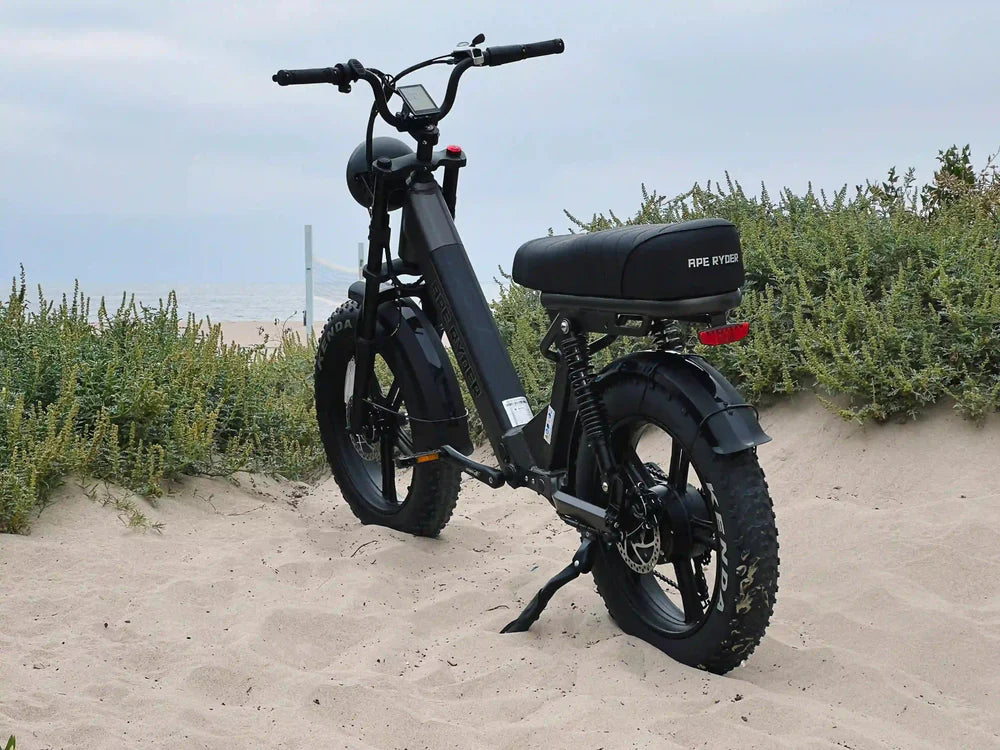Within the past couple of years, e-bikes have gained much popularity among commuters, cycling enthusiasts, and eco-conscious city dwellers. An e-bike is an environmentally friendly, convenient, and time-saving alternative mode of transportation to conventional transportation. In any case, prices for e-bikes can vary significantly, with several models and features available in the market. Knowing what to look out for in pricing an e-bike will help you make a well-informed choice in picking the right one. Further, in this guide, we have rounded up nine major factors which are going to influence costs of your e-bikes. In that way, you will get a proper idea about what to expect and for what reason some features come with a bigger price tag.
Don't forget to check out Ape Ryder's e-bike collection at the end!
The Role of Battery Technology
Battery technology is a major determinant factor in the overall cost of an e-bike. The type, capacity, and quality of a battery will significantly affect the pricing. The most popular lithium-ion batteries are preferred in electric bikes because they are lightweight and durable, performing well, although these are also more expensive than the earlier ones with lead acid. Similarly, batteries with higher capacities for longer travel ranges will raise the overall cost.
The result is that, for example, with extended range, the commuter may find it ideal to get a higher capacity battery for this particular model, although it may be expensive at the beginning. Save the hassle of frequent charging with a high-capacity battery, which would be totally worth the investment if your aim is fewer charges for longer rides.
Motor Power and Performance
The motor in an e-bike really is the powerhouse, and the watt rating involves a great deal of influence on performance and price. A higher-wattage motor equates to increased power, faster acceleration, and superior hill-climbing capability but at increased cost.
A casual rider would most likely find a 250-watt motor ample for his needs, but a person who has to make his way up and down a hilly area would find a 750-watt motor necessary, which would raise the price of the entire bicycle. In choosing a motor's power, one must take into consideration the riding environment in which he usually traverses and the type of performance he will need. If you plan to conquer killer inclines, it may be wise to invest in a more powerful motor.
Frame Material and Design
The material from which the frame is made and the design itself are highly important in terms of pricing for an e-bike. An aluminum frame is lightweight and affordable, hence gaining wide acceptance among riders. Carbon fiber provides better performance at less weight but is more expensive. Complex designs-e.g., integrated suspension or aerodynamic shaping-tend to be cost-increasing.
Value riders, on the other hand, will see a high-end frame as money well spent, while for simple day-to-day riding, one can easily manage with a strong aluminum frame. If you're considering how much to invest in an ebike, consider how and where you plan on using it-and what style of frame best suits your needs.
Advanced Features and Technology
Added to this base, many new ebikes tout a laundry list of technology components: built-in GPS, LCD displays, smart connectivity options, anti-theft devices. The added features significantly enhance your ride but also add price.
Consider what you really need: for short trips within the city, a basic model will most likely be what you require. If your trips are mostly longer, that convenience can be well worth the investment. Keep in mind the kind of roads you would travel by and your requirements before choosing among them.
Brand Reputation and Warranty
Other major pricing factors for e-bikes include brand reputation. A well-established brand, generally offering higher quality and performance features, sells some 20-30% higher compared to the average unnamed company. This generally relates to the cost of funding research and development within a company and also covers customer service-a budget that may take up some 15%. Well-established brands also usually provide good warranty.
When selecting an e-bike for your purchase, take the brand reputation, warranty cover, and customers' review into consideration, as these factors determine about 75% of purchasing decisions. Ensuring that such elements are in place will guarantee that you make a very informed and somewhat long-term investment.
Assembly and Customization
E-bikes come either fully assembled or in kit form, requiring a degree of assembly. Completely assembled models are usually more expensive, in the range of $1,000 to $5,000, due to the added labor costs. The more economy versions will allow the customer to choose certain components themselves and range from $1,200 to $6,000, depending on how much customization you desire.
Think about your technical skills and your willingness to assemble or customize your e-bike to decide between these options. The time taken might range from a few hours up to a whole day, so keep in mind how comfortable you are with a hands-on approach when deciding.
Geographic Location and Market Demand
Pricing for e-bikes largely depends on where you are located because of market demand and shipping costs. Places like California have high demands for e-bikes, and their prices range from highly competitive to about $1,200 and $2,500. Places where e-bikes are not in demand, such as rural areas, have higher prices due to low stock and might even go over $3,000. This can also mean that importing e-bikes from overseas brands will involve extra shipping and import costs, adding anywhere between $100 and $500 to the price.
To find the best deal, take a little bit of time exploring local options and comparing prices between retailers. A little research regarding local availability will go a long way toward ensuring you get the most value for your investment.
Environmental and Regulatory Factors
From ebikes, environmental regulation and policy do make many differences in pricing. For example, in the U.S., federal tax credits as high as $1,500 can be available for qualifying e-bikes. Further rebates from some states and cities may reduce several hundred dollars from the overall cost. On the other hand, more stringent regulations mean the introduction of more safety standards, which will increase the production cost and hence the selling price of ebikes.
Paying attention to local policies will help you avail the incentives at hand and work your budget in case changes in costs arise. The aforementioned factors will help you make a more economically friendly choice while supporting eco-friendly transportation.
Financing and Payment Options
The financing and payment plans make it increasingly more accessible. "Most retailers offer payment plans that can be stretched over time," he says, "with the lowest as 0% APR for 12 months, which opens up even higher-range e-bikes in the $1,500-$4,000 price range to more customers. Some stores also grant 10% off for those who pay upfront.
Consider your financing options to see what works best for you. Being able to understand what the most influential factors are that set the pricing of e-bikes will empower you toward making a truly educated purchase. Consider what is important to you: battery size-range, motor power, type of frame, advanced features (GPS, smart connectivity), brand, how it is assembled, place of purchase, ecological incentives, or method of payment.
Lastly, consider these factors, and you will be all set to choose an appropriate e-bike for your lifestyle and budget. Delve into the world of e-bikes and come across the great feeling of movement in an eco-friendly yet efficient way.









Leave a comment
All comments are moderated before being published.
This site is protected by hCaptcha and the hCaptcha Privacy Policy and Terms of Service apply.